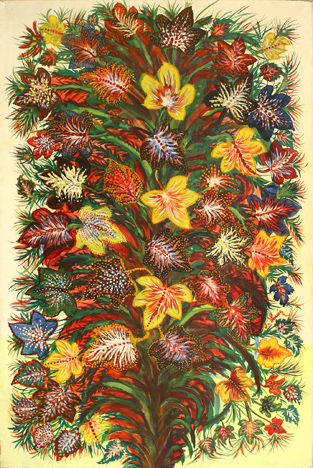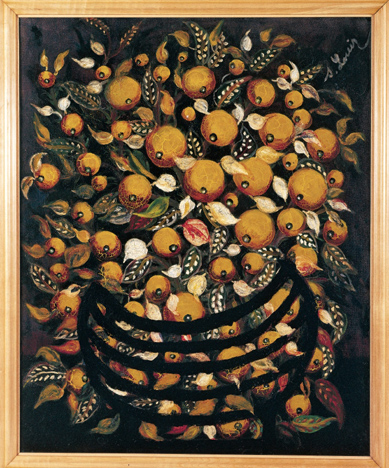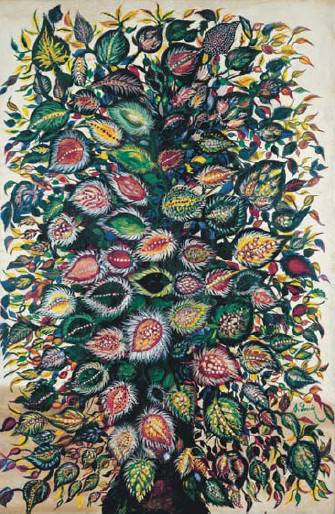Seraphine & Mystical Inner Visions
Hypnotic art. A relationship between an avant-garde art dealer and a visionary cleaning lady. There is a mystery of creativity and the resilience of one woman’s spirit. It is also a marginalized artist and deeply eccentric individual presented as a victim. An excessive devotion that created intense, surreal illusions on another plane of reality and perception, almost hallucinogenic, that eventually landed her in an insane asylum.
Searphine de Senlis ( 1864-1942 ) was simple, yet complex, and a profoundly devout housekeeper who in 1905 at age 41 — self-taught and with the instigation of her guardian angel — began painting brilliantly colorful canvases. In 1912 Wilhelm Uhde, a German art critic and collector — he was one of the first collectors of Picasso and champion of naïve primitive painter Le Douanier Rousseau — discovered her paintings while she worked for him as a maid in his lodgings in Senlis outside Paris. Uhde became her patron and grouped her work with other naïve painters – the so-called “Sacred Heart Painters” .
She was a naive painter, a not truly defining category, but unavoidable term indicating that although she was never trained in painting, she painted as a way to act out a sort of compulsion, what now is sometimes termed visionary art or what Uhde termed primitive modernism.
She painted nothing but flowers, leaves and fruit, but hers bear little relation to their natural counterparts. Descriptive or decorative purposes were completely foreign to her art of mystical effusion. The great stained-glass flames in the churches of Senlis, the only possible sources of inspiration of the pious Séraphine, perhaps gave her the idea for the ascending rhythms that activate her large canvases. The details of these works give access to a strange inner world: leaves, whose centre is a fruit or upon which eyes open and lips appear, fringed with lashes, recall peacock’s plumage and the wings of the rarest birds.
The precision and sureness of these imaginary forms is emphatic and striking, as well as the magic richness of the colours of which she always guarded the secret of her enameled technique. This technique had a certain resemblance to Persian ceramics. The balance and harmony of the canvases,the overall composition, follows a coherent but inhabitual order, marked by an absence of repetition. Her feral intensity and use of color, light, movement and thick impasto are similar to Vincent Van Gogh’s paintings of sunflowers and starry nights.
Her art was refracted through the bizarre lens of Séraphine’s inner vision. She claimed that heavenly voices directed her to paint, visions that later became delusions strong enough to land her in a mental asylum in Clermont, where she died after a long incarceration. These plants, often dotted and striped like caterpillars or other insects, seem to quiver with life, making them seem more like the fauna of a psychotic landscape.
For most of her life, Séraphine painted in total obscurity, scrimping together enough money from the various types of menial labor on which she subsisted to buy a few art supplies. She mixed these with pigments of her own devising, colors distilled from plant and animal sources familiar to her. These vibrant colors are are one of the hallmarks of her work.
There is an immersion into the sensual and spiritual dimensions of Séraphine’s art,a clash of constellations, of cosmic proportions, which grows out of an ecstatic — both in the erotic and religious sense — engagement with the natural world. She paints fruits and flowers in arrangements that at first look merely decorative, like the patterns on wallpaper or pottery, but that on closer examination are charged with a mconsuming and unsettling power resulting from the tension of two opposites colliding.
The lyricism and the color palette recall Persian art, and more particularly the Sufi phenomenon of Persian mysticism which weaves and leaves traces within and without her own idiosyncratic form of Christian mysticism. The tension derives from adherence to orthodox church doctrine, yet simultaneously feeling the pull and attraction of mysticism ; to be set free from external rules and open to the movement of the spirit.




It is amazing all the artistic talents and masterpieces
we can discover in psychiatric institutes !!!
These unknown artists should be encouraged and helped but in the contrary,they are to often exploited…..
An excellent film about the life of an amazing artist and woman. Thank you for sharing this.
The movie was totally inspirational and revealed an artist I did not know. Her beautiful work reminds me of Frida Kahlo’s. I think those two would have liked each other.
Thanks for reading. Thats a very interesting connection to make between Kahlo and Seraphine. I have not written about Kahlo yet, but your comments will be somethig to keep in mind. Best,
Dave